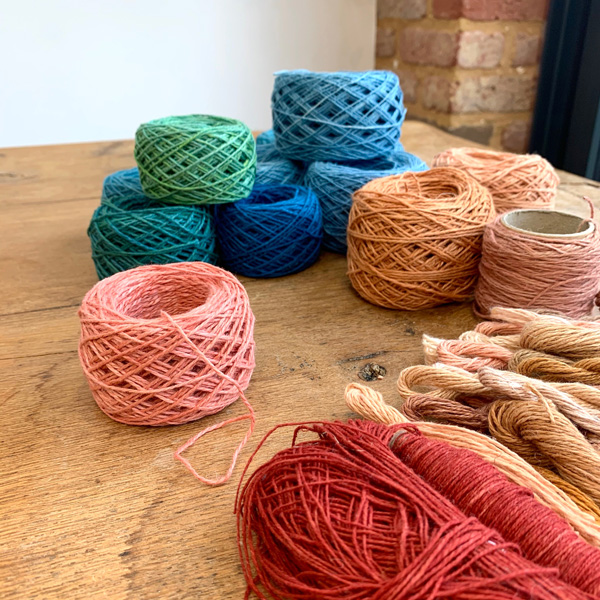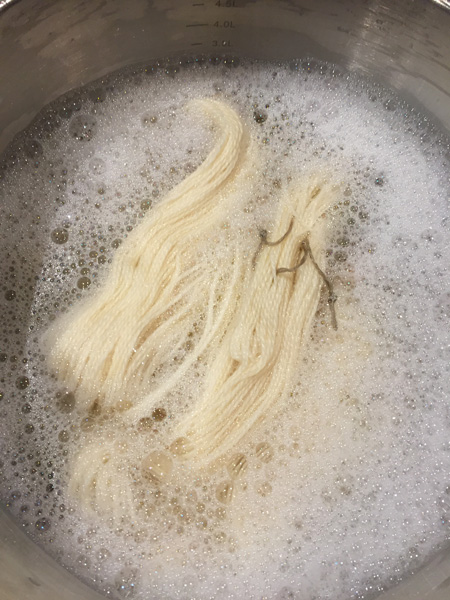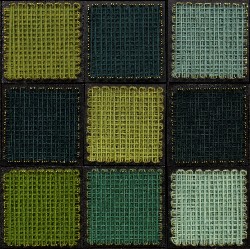The Pleasures and Pitfalls of Naturally Dyeing Linen Yarn
Claudia Gosse
I began experimenting with natural dyeing a couple of years ago when my daughter, Ellie Fisher, moved to a vegan diet and wanted to reflect this lifestyle choice in her weaving. Having focused for some time on recycled and organic yarns she asked me if I could produce some naturally dyed linen yarn for one of her projects.

Ellie studied at Central St. Martin's, the internationally renowned college of Art in London, graduating in 2004 with an MA in Textile Design. She now works from her studio in Winchester, where she produces bespoke pieces with an emphasis on sustainability. She also runs weaving workshops for complete beginners through to more advanced learners (www.elkatextiles.co.uk).
|
Claudia, Ellie and Frankie outside Ellie's studio
|
||
 |
||
| Photograph Copyright by Claudia Gosse |
My background is in teaching, specialising in prison education, but I've always had an interest in textiles, both sewing and knitting. Natural dyeing is a new venture to me and discovering the range and vibrancy of natural dyestuffs has been exciting, if occasionally frustrating! Apart from attending natural dyeing workshops, reading widely and experimenting myself, I've returned repeatedly, for support, to Jenny Dean's Wild Colour and The Art and Science of Natural Dyes by Joy Boutrup and Catherine Ellis. Running introductory natural dyeing workshops enables me to apply my teaching to a fascinating new subject.
Cellulose (plant) fibres are more resistant to dye than protein (animal) fibres, and achieving even, strong results on linen seems to be a particular challenge. For this reason, last summer Ellie and I headed for northern France to spend a weekend with Debbie Bamford at her workshop near Arras. Debbie specialises in authentic medieval dyeing for re-enactment groups and has a lot of experience in the natural dyeing of linen (www.mulberrydyer.co.uk). I was particularly interested to know more about dyeing with madder, on which Debbie is an expert.
Following my rather mixed early results, I very soon learned that successful dyeing starts with effective scouring. The first time I scoured linen for a couple of hours in soda ash and a neutral washing liquid, I was quite amazed at the colour of the water. How could this creamy-white, half-bleached fibre have turned the solution dark brown? The answer is that the linen fibres contain natural waxes and oils that can hinder the absorption of dye if not removed, as well as various "sizings", or protective coatings, applied to fibres during the manufacturing process. I now scour all linen fibre twice to clean it as thoroughly as possible before moving on.
| Linen yarn before scouring | Linen yarn in the scoup pot after 2 hours of simmering |
 |
 |
| Photograph Copyright by Claudia Gosse | Photograph Copyright by Claudia Gosse |
Working with cellulose/plant fibre means that mordanting has to be done in two stages, first with tannin and then with alum (aluminium potassium sulphate). Although tannin has a natural affinity with cellulose, it is not stable in the fibre until the alum mordant is added. My initial failure to understand this meant that I was rinsing the fibre too thoroughly between the tannin and the alum mordant baths. A lot of the tannin was being lost, leaving little for the alum to adhere to, and therefore the for subsequent dye also. Results were often patchy and weak. My current practice is to squeeze the tannin gently from the linen skeins and either add the skeins directly to the alum/soda ash mordant bath or, if necessary, give them a cursory rinse to remove any surface sediments.
With so much information now available on natural dyestuffs it took me a while, and a few disappointments, to find the ones that give reliable, lightfast and washfast results. Logwood was a particular revelation: such a stunning range of the most beautiful purples, only to see them wash away and fade to grey at the slightest excuse–very disheartening! Foraged elderberries brewed up a spectacular dye but with similar results and red cabbage, widely promoted on YouTube sites, falls into the same bracket. Beware the lure of instant purple! (Anthocyanin pigments lack affinity for fibre). Not for nothing is it the colour of kings, historically obtained from the murex sea snail–thousands of which were required for the royal robe.
There is nothing more rewarding than to head out in search of seasonal, foraged dyestuffs and to watch them transform your fibres into an artist's palette of colours, from subtle to bold and always surprising. My successes this year included dandelion heads in the spring, summer comfrey leaves, autumn black walnut hulls, and wild cherry bark from a fallen tree this winter. But the time-honoured, reliable natural dyes, such as indigo, madder and weld, exploited by ancient and skilled dyeing communities around the world for millennia, are indispensable. Happily, I have much more to discover.


Bibliography
Boutrup, Joy and Catharine Ellis. 2018 The Art and Science of Natural Dyes. Schiffer Publishing Ltd, Atglen, PA
Dean, Jenny. 1999, 2010 Wild Colour. Octopus Publishing Group Ltd, London and Watson-Guptill Publications, New York
 Turkey Red Journal
Turkey Red Journal
